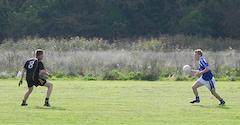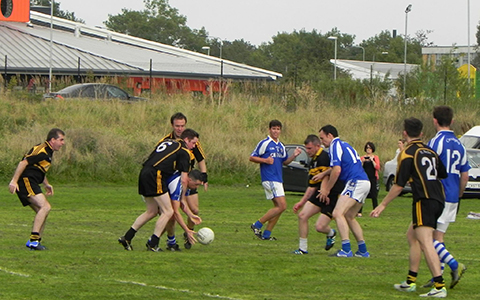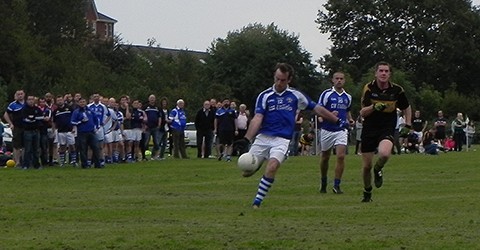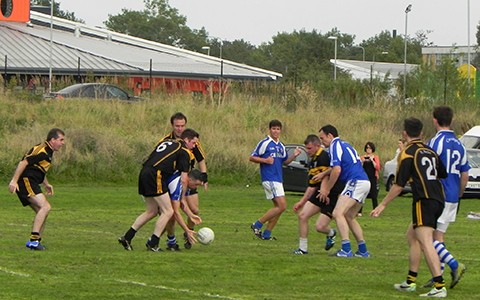What is Gaelic?
Gaelic football is one of the oldest sports in the world. It originates from Caid, a type of ancient ball sport like the traditional Welsh game of Cnapan. The earliest mention of it in records is from 1308.
The Gaelic Athletic Association (GAA) was founded in 1884 as part of the Gaelic Cultural Revival, and codified the rules of the game. It organises matches at club, county and country level.
The GAA is the largest amateur sports organisation in the world. The season runs from spring through summer.
The Rules
A Gaelic match at senior county level lasts 70 minutes, with two halves of 35 minutes. Two teams of 15 (including a goalkeeper) take to the pitch.
Although called football, most of the time the ball is kept in the player’s hands. It can only be passed to another player by a kick or a handpass.
The player must do something with the ball every 3 steps, either bounce it on the ground, or kick it into their hands (hop).
A point is scored when the ball is sent over the opposing team’s crossbars. A goal (worth 3 points) is scored when the ball goes into the opposing team’s net.
Although aggressive play is expected (and somewhat tolerated) by officials, foul play can cause a yellow card (a caution), a red card (sent off the pitch without a substitution) or the recently introduced black card (sent off the pitch with a substitution) to be issued by the referee.
To learn more about St.Colmcille’s visit their Facebook page or check out their Twitter.
With immigration a hot button issue, how do these newcomers keep their culture in a different country? Gaelic football (aka GAA) serves as a linchpin for Irish immigrants to celebrate their culture wherever they are in the world, including Cardiff.
Ireland is celebrating a streak of success in international sports, but their national game, Gaelic, is not one of these. A sport with a long history, these ties are kept strong by local team St. Colmcille’s.
This popularity means that the sport has been exported around the world with the Irish diaspora. Established in 1956, St. Colmcille’s GAA (Gaelic Athletic Association) club now has 150 members. It was formed to promote Irish culture and to provide a link to home for immigrants.
“I think Gaelic plays a massive role in keeping Irish people in touch with the homeland. The club is a community which creates a home from home for everyone involved,” says Kate Cunningham, captain of Colmcille’s ladies team. Kate moved to Cardiff last year and notes that she has women from Ireland getting in touch before they move over, which indicates the desire among ex-pats to maintain their links to Ireland.
This is a sentiment shared by Aidan Farrelly, a member of Colmcille’s men’s team, who has lived in Cardiff for eight years. He says that the club uses every opportunity to promote the sport, including appearing on S4C and fundraising for local charities annually. He adds that the club is “inclusive” of everyone, regardless of nationality.
Aidan draws parallels between the Irish and Welsh cultures, comparing the local Gaelic club’s role in the Irish community to that of the local rugby club in a Welsh one. He states that living abroad for anyone, “Makes you more aware of your own heritage and keeping your own sense of cultural identity.”
What is Gaelic?
Gaelic football is one of the oldest sports in the world. It originates from Caid, a type of ancient ball sport like the traditional Welsh game of Cnapan. The earliest mention of it in records is from 1308.
The Gaelic Athletic Association (GAA) was founded in 1884 as part of the Gaelic Cultural Revival, and codified the rules of the game. It organises matches at club, county and country level.
The GAA is the largest amateur sports organisation in the world. The season runs from spring through summer.
The Rules
A Gaelic match at senior county level lasts 70 minutes, with two halves of 35 minutes. Two teams of 15 (including a goalkeeper) take to the pitch.
Although called football, most of the time the ball is kept in the player’s hands. It can only be passed to another player by a kick or a handpass.
The player must do something with the ball every 3 steps, either bounce it on the ground, or kick it into their hands (hop).
A point is scored when the ball is sent over the opposing team’s crossbars. A goal (worth 3 points) is scored when the ball goes into the opposing team’s net.
Although aggressive play is expected (and somewhat tolerated) by officials, foul play can cause a yellow card (a caution), a red card (sent off the pitch without a substitution) or the recently introduced black card (sent off the pitch with a substitution) to be issued by the referee.
To learn more about St.Colmcille’s visit their Facebook page or check out their Twitter.








